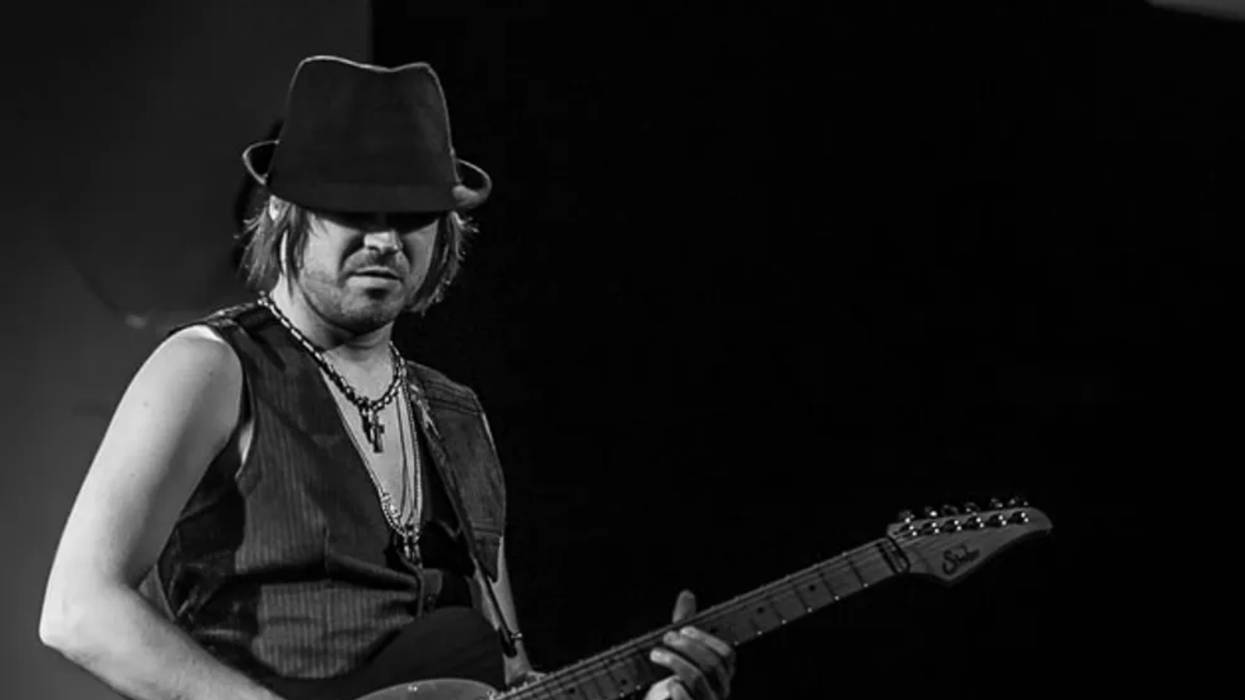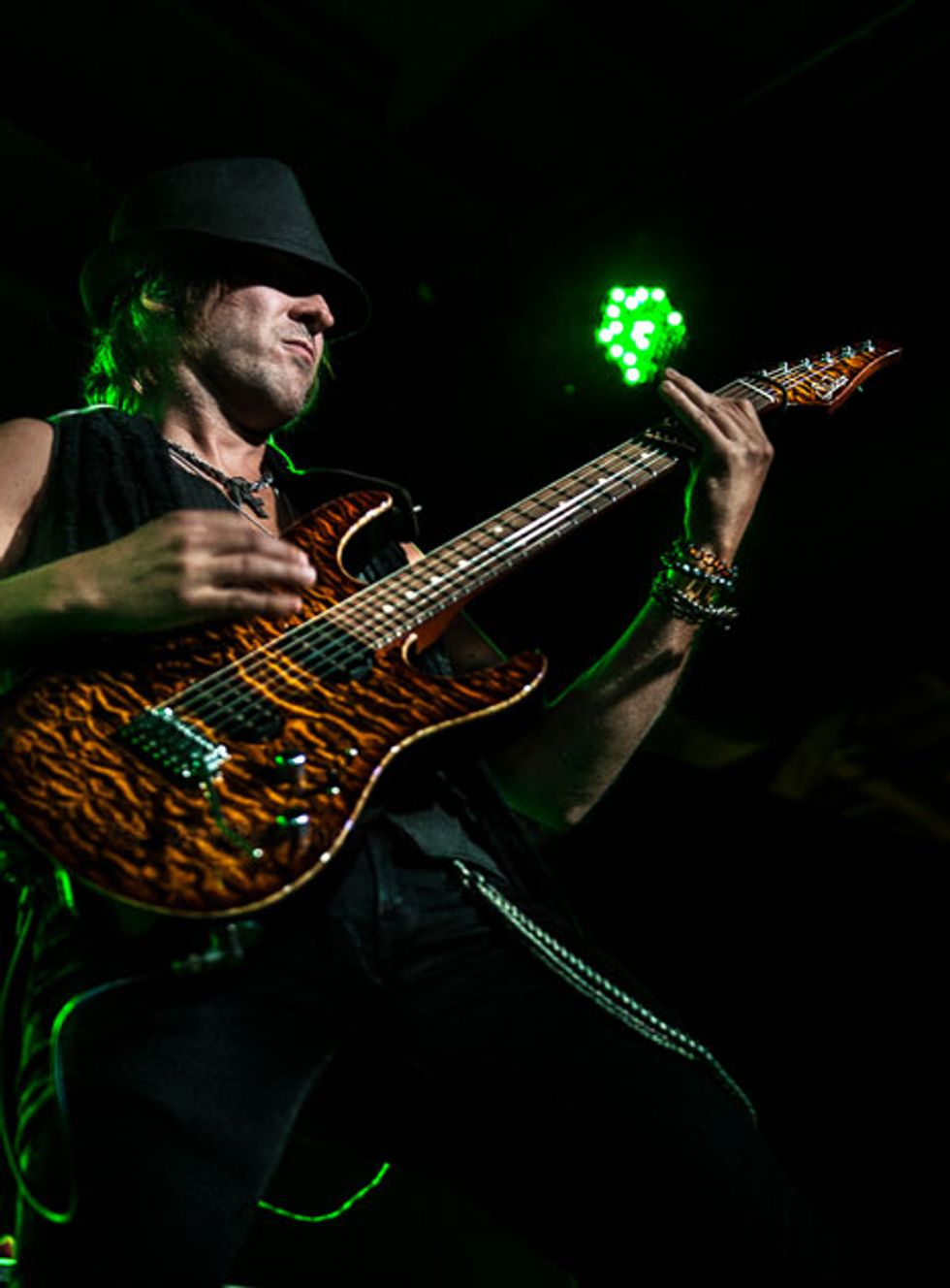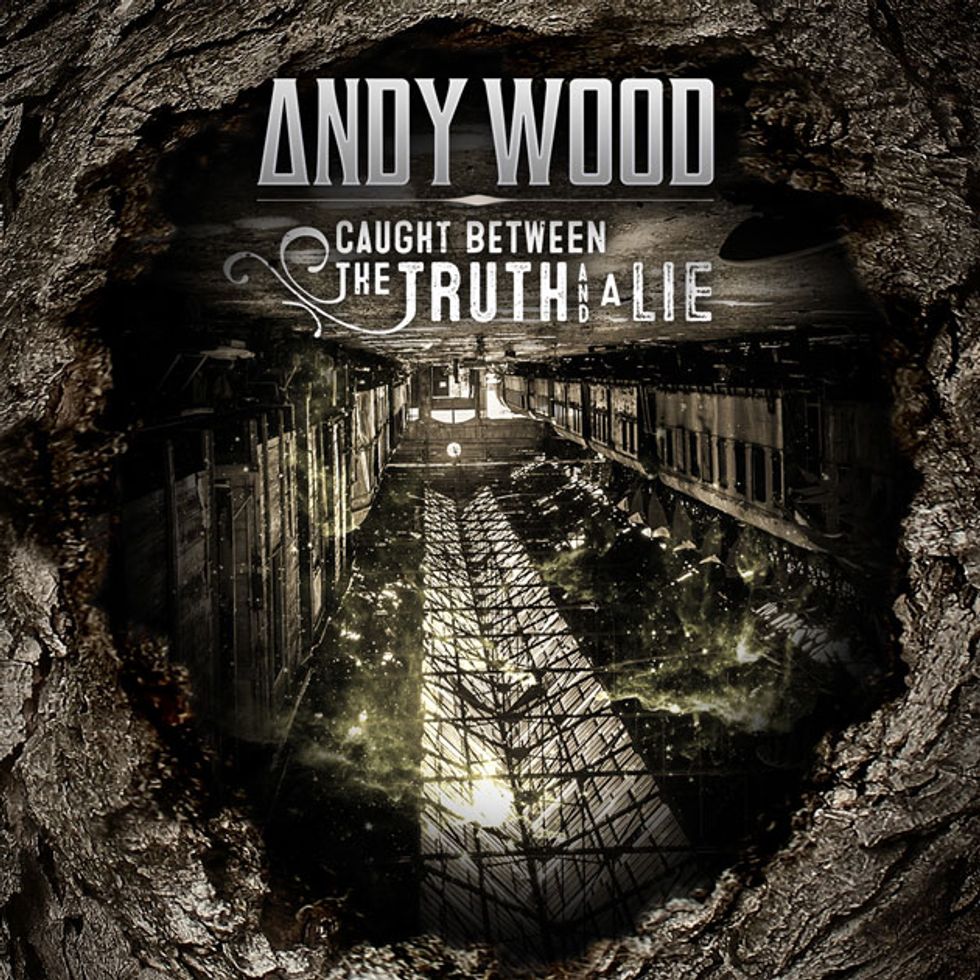Few guitar shredders, when presented with a dreadnought set up for bluegrass playing, could make the instrument sing. Fewer still would know what to do with a mandolin. But electric virtuoso Andy Wood is equally dexterous on flattop acoustic and mandolin. All sides of Woods' musical life are displayed on his new double-disc album, Caught Between the Truth and a Lie, the follow-up to his 2012 debut, A Disconcerting Amalgam.
Wood is most visible as a sideman to vocalists such as Scott Stapp and Sebastian Bach. Those gigs display Wood's sensitivity as an accompanist, but not the full range of his skills and experience.
Wood was a mere preschooler when his grandfather started teaching him mandolin. He eventually entered the competition circuit, winning second place in the World Champion Mandolin contest by age 16. He's played guitar nearly as long, but didn't take up electric until he was a teen. When he did, his mind exploded. He discovered both country greats like Brent Mason and Albert Lee and pyrotechnical rockers like Steve Vai and Joe Satriani, He eventually synthesized both styles into his own idiosyncratic approach, one that helped him triumph over thousands of rivals in Guitar Center's Guitarmageddon Competition in 2003. Around then he also founded a hard rock band, Down From Up.
But Wood never left country behind. He's long been in demand as both a Nashville session musician and a clinician/educator. We chatted with him about how he manages to unite so many musical strands, and the tools he uses to do so.
What was it like playing mandolin as a kid?
It was really good for me. I played mandolin and my cousin played fiddle. When you're that young—we were 4 or 5—you don't realize how technically demanding uptempo bluegrass is. You just don't think of it as being hard. My grandpa showed me a bunch of traditional tunes that I learned by ear. That's where all my right-hand and alternate-picking facility comes from. I didn't learn the way guitar players typically do, dissecting the way highly technical players approach the instrument. Learning like I did was a great foundation, certainly a much different one than, say, sitting around watching YouTube videos.
Talk about finally discovering the electric guitar.
I started playing electric when I was about 17. I was working in a theater in Pigeon Forge [Tennessee] when one of the other musicians said my right hand was technically very advanced, and that I must have been listening to a lot of Paul Gilbert. At the time, I had no idea who that was. So the guy made me a tape, kind of the 101 of instrumental guitar, with pieces by Steve Vai and “Cliffs of Dover." But what really got me serious was listening to Brent Mason's solo on “Pick It Apart" [from Mark O'Connor's The New Nashville Cats, 1991], which I bought because all my bluegrass heroes are on it. When I heard the solo I just thought, “That's where I'm headed." I still remember that solo note-for-note. A friend who's a professional transcriber recently tabbed out the solo, and I was able to point out some inconsistencies between the transcription and what Mason actually plays. That's how deeply I got to know the solo.
YouTube It
Andy Wood plays the title track from his new album on a Custom Classic T model at the 2014 Suhr Factory Party.
To what do you attribute your success as a session player and sideman?
It's probably my general professionalism. We as guitar players have a bad tendency to let our egos determine what we can and can't do. For the gig with Sebastian Bach, for example I just tried to do exactly what was required to fulfill his vision and not overplay. I always strive to dial in just the right tone that the artist needs, even if it's not what I prefer. Scott Stapp, for instance, likes scooped highs and lows, but I like fat midrange. It's not my name in lights, so I do what the gig needs and make my own music, on my own terms, on the side.
Tell us about some of your recent session work.
Sessions are funny—they're never the same, but always the same. You get a call at the last minute for some random mandolin or banjo part—I don't normally play banjo, but can do a convincing overdub. Sessions tend not to be too technically demanding—I often track quickly, in one or two takes. Basically, most gigs just require that I stay in tune and have a tone that doesn't suck. People tend not to care too much about chops. There's a misconception among young players that you always have to play with the same tone, but most situations require that you be able to take off one pair of shoes and put on another.
What's the meaning of the album's title, Caught Between the Truth and a Lie?
It's an old saying from my grandpa. Sometimes when we used to watch the Academy of Country Music Awards, with all these guys playing their electrics and their gadgets, he would say, “You don't need all that—you just need a Martin and the truth." And he was right. Some players might be off the chain on the electric, but hand them a Martin with high action and .013s, and their technique just shrinks. So the lie is an electric guitar with low action, and the truth is a good old Martin. Somewhere between the two is where I'm at.
“Pop music could use a little injection of smarter harmony, which is what I try to bring to the table,"
says Nashville guitarist Andy Wood. Photo by Andrew Fore.
Why a double album?
A lot of people in the community view me as a rock-fusion instrumental guitar player, but first and foremost, I'm a mandolin player at heart. So I wanted to do something cool for the guy or gal who knows Steve Vai but not Sam Bush, to show those fans that there's all this other stuff I do and feel close to. But for the fans that don't care about hillbilly stuff, there's a whole side of fusion guitar solos.
Is it difficult to move between guitar and mandolin?
I wrote the title track on mandolin, and it fits so easily on the instrument that I can really fly through it. But if I try to play it on guitar, it's a nightmare. Paul Gilbert–style arpeggios with wide stretches on the guitar are easier to play on mandolin, with its smaller scale and [perfect fifth] tuning. Bebop lines, on the other hand, are way easier on guitar. Keys like Bb and Eb suck to play on mandolin. When I was young I transcribed [AC/DC's] “Thunderstruck" and learned it in a different key on mandolin. Sometimes a great Vai or George Benson tune makes a great mandolin workout. On the other hand, I don't really go from guitar to mandolin, and much of the music I like—Chick Corea, Béla Fleck—isn't on guitar or mandolin. Speaking of Béla Fleck, I really like to transfer banjo parts to the mandolin. I often feel like I play the mandolin like a banjoist.
How do you reconcile the worlds of metal and bluegrass?
On one hand, when it comes to riffing and rhythm, it's like apples and bicycles—not even close to the same worlds. But when it comes to soloing, they're very much alike. Eric Johnson lines, Steve Morse lines—when you think about it, those are essentially mandolin and fiddle melodies played on guitar.
There's also a hint of jazz to your playing.
Jazz and bluegrass are a lot alike. In both, musicians play heads, or tunes, which they use as springboards for solos. That's probably why I gravitated toward jazz when I went to the University of Tennessee for two years. In college I learned enough jazz not to feel alienated if people are sitting in a room playing standards. I love to play fusion tunes like [Chick Corea's] “Spain" at shows, with a lot of distortion. That's where I live: kind of in Al Di Meola territory, though I'm not necessarily a hardcore jazz guy.
On the acoustic side of the album, you nailed an electric song—Led Zeppelin's “Fool in the Rain"—in exacting detail.
The Led Zeppelin cover was quite a task. We transferred every single element over from one format to another. The original keyboards I play in a chord-melody style. The drums have been assigned to hand percussion. The mandolins all go after Robert Plant's vocal mannerisms. We even used a wooden whistle to copy the original recording. Everything was acoustic, and I'm proud of the way it turned out.
While the electric side has fiery moments, it seems to display a bit more restraint than your debut album.
This album is a bit more mature than the first, where I was trying to cram in as many different 32nd notes as possible into an 11/8 time signature. This one has a lot of tunes like “Reach" and “The Hardest Goodbye," which are indebted more to Jeff Beck than to Paul Gilbert. I don't have anything to prove this time. That's not to say there aren't a lot of notes, but I feel it's okay to do a song like “For the Queen," which is a more lyrical piece with just cello and electric guitar, and not have to prove how technically adept I am with every song. That's why there are way more ballads this time around.
Andy Wood's Gear
Guitars
Fender Telecaster with B-bender
Martin HD-28
Assorted Suhr Classics and Moderns
Amps
Diezel Herbert
Dr. Z Z Wreck
1963 Fender Deluxe Reverb
KSR Colossus
Effects
Fractal Audio Axe-FX II
Carl Martin Compressor/Limiter
MXR EVH Phase 90
Suhr Shiba Drive Reloaded
Assorted T.C. Electronic Toneprint pedals
Strings and Picks
Assorted D'Addario strings
Custom BlueChip picks
Talk about your compositional process.
Most of time it starts with something I'm humming in my head or a rhythm I'm drumming. I'm very fidgety—I'm fundamentally a rhythmic person. When I drive, I play air drums rather than air guitar, and that influences my writing a lot. I have an iPad filled with random thoughts that I jot down as I go through the day, some personal and others political. And when I have a melody floating around in my head, I comb through the thoughts to see if there are any matches.
Do I detect a video game influence on the record?
Yes! I'm actually a hardcore gamer. Right now I'm playing the new Destiny. “Reach" was a melody inspired by Halo, which is based on this sad scenario: All these space marines are on a planet, trying to defend it, and they die one by one. The melody definitely reflects that. Video games these days are so high budget. They get big-name composers like Danny Elfman and even guitarists like Steve Vai, who did the music to Halo 2. I think I respond to video game music because it has so much in common with scores for movies like The Lord of the Rings series and The Last Samurai. Every melody is epic and gargantuan, and this makes me feel something that translates well to my guitar playing and writing.
You seem to have an ear for unusual chord progressions. How did you develop this?
It comes from listening to a lot of Django Reinhardt, Dixie Dregs, Danny Elfman. I just love a chord progression that takes you somewhere other than where you think it should go. Most of the time, commercial music ends up with the same old rehashed chord structures. I think it's due to people writing great melodies but not putting too much thought into the way they're harmonized. I feel like pop music could use a little injection of smarter harmony, which is what I try to bring to the table.
Can you talk about specific harmonic moments?
“Reach," for example, is in the key of E minor, then E major. Using a chord based on the flatted seventh [D], I get a chord progression of C–D–E to get between major and minor. The melody could've been harmonized strictly in E minor, but I feel that my harmonic choices make it more epic sounding. In another instance, A minor and F minor chords are definitely not supposed to go together. I use them to make my tribute to Elfman, “Of Elf and Man," with this melody that's all kooky and weird, like Edward Scissorhands translated to sound.
Which guitars did you use on the record?
This will be a long-winded answer with a 24-song album! I wanted to avoid having a sonic stalemate with just one guitar. That would have just been too fatiguing, so I wanted to give the listener lots of different tonal colors. For electrics I used a Suhr Classic, their interpretation of a Strat, very vintage-sounding with low-output, single-coil pickups. That guitar did most of the heavy lifting for the ballads. And I used quite a few Suhr Moderns, both mahogany and alder, for the crunchy, big-gain parts, and for some admittedly childish tappy-tap licks.
I also had my Fender Telecaster, the second guitar I ever owned, which has a B-bender, Seymour Duncan pickups, and stainless steel frets. I once had this moment when transcribing a Diamond Rio song, and I couldn't figure out what Jimmy Olander [known for using B-bender-outfitted guitars] was doing. So I kind of wanted to do the same and confound people—in a good-natured way—who attempt to transcribe my playing. On “For the Queen," I used a beautiful 1967 ES-335 through my '63 Fender Deluxe Reverb, and on “Dracula," I play my Ibanez George Benson.
On the acoustic side, I mostly used the guitar my granddad got me for my 16th birthday: a particularly lush-sounding Martin HD-28 with a V-shaped neck. For the swing tune “Everybody Loves You," there's a $150 POS acoustic that barely stays in tune. I won't name the maker, but it makes this great snappy sound that you just can't get through post-EQ. On “Time," I've got a Gitane Django, a really pretty, cool-sounding guitar made from bird's-eye maple and spruce. And my mandolin is by Flatbush, a Danish maker.
What about amps?
I used the 1963 Deluxe Reverb that is the crown jewel of my collection. I worship Brent Mason, and when I heard that he played one, I had to go out and find one for myself. There's a KSR Colossus amp that I use for more silky, violin-like lead tones, and a Diezel Herbert for big, raunchy tones. For country stuff I used a lovely Dr. Z Z Wreck. That's it: four great amps that covered everything.
What's been your most satisfying gig of late?
There's this venue in Nashville called the Station Inn, which features mostly bluegrass acts. Not long ago I got a call from Paul Brewster, the great country singer, to go in and lay down some real traditional tunes there with a bunch of serious country musicians. We go back 50 years in time—it's rad and so fun. The band has four incredible singers with the melodies stacked up so high. Paul can harmonize with a dog whistle—he just puts the music up in the rafters. As a session player I get to hear how things sound behind the scenes. When you take the curtain off, most singers just don't sound as good as they do on recordings. But that guy is just tuner-perfect. And it's just so inspiring to play the music that's so close to my heart with such amazing musicians. It represents the truth for me.













![Rig Rundown: Russian Circles’ Mike Sullivan [2025]](https://www.premierguitar.com/media-library/youtube.jpg?id=62303631&width=1245&height=700&quality=70&coordinates=0%2C0%2C0%2C0)













![Rig Rundown: AFI [2025]](https://www.premierguitar.com/media-library/youtube.jpg?id=62064741&width=1245&height=700&quality=70&coordinates=0%2C0%2C0%2C0)




















 Zach loves his Sovtek Mig 60 head, which he plays through a cab he built himself at a pipe-organ shop in Denver. Every glue joint is lined with thin leather for maximum air tightness, and it’s stocked with Celestion G12M Greenback speakers.
Zach loves his Sovtek Mig 60 head, which he plays through a cab he built himself at a pipe-organ shop in Denver. Every glue joint is lined with thin leather for maximum air tightness, and it’s stocked with Celestion G12M Greenback speakers.











